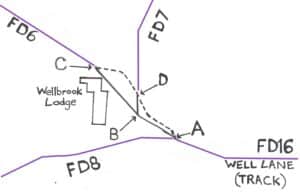Support us from £3/month
We deal with almost 1000 cases a year assisting communities, groups and individuals in protecting their local spaces and paths in all parts of England and Wales. Can you help us by joining as a member?
We have scored an important legal victory against West Northamptonshire Council which has tried unlawfully to close parts of three public footpaths at Staverton, two miles west of Daventry.

Photo of Wellbrook Lodge seen from point A: the definitive route goes through the gate, the proposed alternative is to the right. Photo: Open Spaces Society
The footpaths had been illegally obstructed by gates and fences at Wellbrook Lodge. Instead of carrying out its statutory duty to secure their removal[1] , the council made a temporary traffic regulation order (TTRO)[2] to move the footpaths to an alternative route.
Alerted by our member, Staverton Parish Council, we argued that the TTRO was unlawful, since the grounds for making a TTRO were not met. West Northamptonshire Council said the TTRO was made for ‘public health and safety’ but failed to identify any genuine cause of danger justifying closure. The real reason for making the TTRO was to regularise the unlawful obstructions and unofficial diversion.
We started legal proceedings, and after initial resistance, the council conceded that it had acted unlawfully in making the TTRO rather than dealing with the obstructions. In a consent order of the High Court it has agreed that it has a duty to secure the removal of the obstructions and that it will take steps to do so within three months of the order. It also will pay the society’s reasonable costs in bringing the action.

Map showing the paths. Route to be closed A-B-C and B-D (solid line). Alternative route A-D-C (broken line). Photo: Open Spaces Society
Says Helen Clayton, our rights-of-way case officer: ‘This is an excellent outcome. Too often local authorities try to evade their legal duties on rights of way by moving the path rather than the problem. This case gives a clear message to all local authorities that they must not abuse their powers to make TTROs, and must instead uphold the public’s rights to use and enjoy the paths.’
[1]Under section 130 of the Highways Act 1980 the highway authority (ie West Northamptonshire Council) has a statutory duty to assert the rights of the public to the use and enjoyment of the highway, and to keep highways clear of obstruction. Highways include public footpaths, and it is a criminal offence under section 137 of the Highways Act 1980 to obstruct the highway.
[2]A TTRO is made under section 14(1) of the Road Traffic Regulation Act 1984. It is made by the traffic authority (ie West Northamptonshire Council) temporarily to restrict or prohibit the use of a road (including a footpath) by pedestrians for three purposes: works on or near the road; likelihood of danger to the public; or for litter clearing. A general assertion of ‘public health and safety’ is not a sufficient ground.
